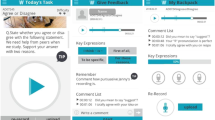Abstract
Can WhatsApp be used as an educational computer system? This question had not been answered conclusively by current research and was a global imperative for the computers and education research and practice communities given that over a quarter of the entire world’s population used WhatsApp. To advance the field, educational theory and practice and to give meaning to WhatsApp in education, empirical quantitative evidence was gathered with a questionnaire to measure mobile collaborative learning on WhatsApp. The results indicated that increased collaboration on WhatsApp improved academic achievement and improving other key aspects such as active learning, trust, support, formality, interaction and interdependence enhanced collaboration and, in turn, improved academic achievement. The study advanced educational computer theory and mobile collaborative learning theory and provided evidence-based learning design guidelines for incorporating WhatsApp into learning programs for improved academic achievement.
Access this chapter
Tax calculation will be finalised at checkout
Purchases are for personal use only
Similar content being viewed by others
References
Statista.com: Most popular social networks worldwide as of October 2020, ranked by number of active users. https://www.statista.com/statistics/272014/global-social-networks-ranked-by-number-of-users/#professional. Accessed 17 Jan 2021
Pimmer, C., Brühlmann, F., Odetola, T.D., Oluwasola, D.O., Dipeolu, O., Ajuwon, A.J.: Facilitating professional mobile learning communities with instant messaging. Comput. Educ. 128, 102–112 (2019). https://doi.org/10.1016/j.compedu.2018.09.005
Eid, M.I.M., Al-Jabri, I.M.: Social networking, knowledge sharing, and student learning: the case of university students. Comput. Educ. 99, 14–27 (2016). https://doi.org/10.1016/j.compedu.2016.04.007
Rasheed, M.I., Malik, M.J., Pitafi, A.H., Iqbal, J., Anser, M.K., Abbas, M.: Usage of social media, student engagement, and creativity: the role of knowledge sharing behavior and cyberbullying. Comput. Educ. 159, 1–12 (2020). https://doi.org/10.1016/j.compedu.2020.104002
Alkhalaf, A.M., Tekian, A., Park, Y.S.: The impact of WhatsApp use on academic achievement among Saudi medical students. Med. Teach. 40, S10–S14 (2018). https://doi.org/10.1080/0142159X.2018.1464652
Whelan, E., Islam, A.K.M.N., Brooks, S.: Applying the SOBC paradigm to explain how social media overload affects academic performance. Comput. Educ. 143, 1–12 (2020). https://doi.org/10.1016/j.compedu.2019.103692
Liebherr, M., Schubert, P., Antons, S., Montag, C., Brand, M.: Smartphones and attention, curse or blessing? - A review on the effects of smartphone usage on attention, inhibition, and working memory. Comput. Hum. Behav. Rep. 1, 1–8 (2020). https://doi.org/10.1016/j.chbr.2020.100005
Lacka, E., Wong, T.C., Haddoud, M.Y.: Can digital technologies improve students’ efficiency? Exploring the role of virtual learning environment and social media use in higher education. Comput. Educ. 163, 1–11 (2021). https://doi.org/10.1016/j.compedu.2020.104099
Manca, S., Bocconi, S., Gleason, B.: “Think globally, act locally”: a glocal approach to the development of social media literacy. Comput. Educ. 160, 1–17 (2021). https://doi.org/10.1016/j.compedu.2020.104025
Giunchiglia, F., Zeni, M., Gobbi, E., Bignotti, E., Bison, I.: Mobile social media usage and academic performance. Comput. Human Behav. 82, 177–185 (2018). https://doi.org/10.1016/j.chb.2017.12.041
Fu, Q.-K., Hwang, G.-J.: Trends in mobile technology-supported collaborative learning: a systematic review of journal publications from 2007 to 2016. Comput. Educ. 119, 129–143 (2018). https://doi.org/10.1016/j.compedu.2018.01.004
Kirschner, P.A., Sweller, J., Kirschner, F., Zambrano, J.: From cognitive load theory to collaborative cognitive load theory. Int. J. Comput.-Supp. Collab. Learn. 13(2), 213–233 (2018). https://doi.org/10.1007/s11412-018-9277-y
MacKenzie, S.B., Podsakoff, P.M., Podsakoff, N.P.: Construct measurement and validation procedures in MIS and behavioral research: integrating new and existing techniques. MIS Q. 35, 293–334 (2011). https://doi.org/10.2307/23044045
Nyembe, B.Z.M., Howard, G.R.: Development of a Quantitative Instrument to Measure Mobile Collaborative Learning (MCL) Using WhatsApp: The Conceptual Steps. Lecture Notes in Computer Science 12066, 507–519 (2020). https://doi.org/10.1007/978-3-030-44999-5_42
Allen, J.D.: Grades as valid measures of academic achievement of classroom learning. Clear. House A J. Educ. Strateg. Issues Ideas. 78, 218–223 (2005). https://doi.org/10.3200/TCHS.78.5.218-223
Sekaran, U., Bougie, R.: Research Methods for Business: A Skill Building Approach. John Wiley and Sons, Chichester, United Kingdom (2013)
Tongco, M.D.C.: Purposive sampling as a tool for informant selection. Ethnobot. Res. Appl. 5, 147–158 (2007). https://doi.org/10.17348/era.5.0.147-158
Hoe, S.L.: Issues and procedures in adopting structural equation modelling technique technique. J. Appl. Quant. Meth. 3, 76–83 (2008). https://ink.library.smu.edu.sg/sis_research/5168
Love, J., et al.: JASP: Graphical statistical software for common statistical designs. J. Stat. Softw. 88, 1–17 (2019). https://doi.org/10.18637/jss.v088.i02
Nunnally, J.C.: Psychometric Theory. McGraw-Hill, New York (1976)
Costello, A.B., Osborne, J.: Best practices in exploratory factor analysis: Four recommendations for getting the most from your analysis. Pract. Assessment, Res. Eval. 10, 1–9 (2005). https://doi.org/10.7275/jyj1-4868
Worthington, R.L., Whittaker, T.A.: Scale development research: a content analysis and recommendations for best practices. Couns. Pyschol. 34, 806–838 (2006). https://doi.org/10.1177/0011000006288127
Reinard, J.C.: Communication Research Statistics. Sage, Thousand Oaks, California (2006)
Howard, M.C.: A review of exploratory factor analysis decisions and overview of current practices: what we are doing and how can we improve? Int. J. Hum. Comput. Interact. 32, 51–62 (2016). https://doi.org/10.1080/10447318.2015.1087664
Tredoux, C., Durrheim, K. (eds.): Numbers, Hypotheses & Conclusions: A Course in Statistics for the Social Sciences. UCT Press, Cape Town (2005)
Rosseel, Y.: lavaan: an R package for structural equation modeling. J. Stat. Softw. 48, 1–36 (2012). https://doi.org/10.18637/jss.v048.i02
Rosseel, Y.: The lavaan tutorial. https://lavaan.ugent.be/tutorial/index.html. Accessed 25 May 2021
Schreiber, J.B., Nora, A., Stage, F.K., Barlow, E.A., King, J.: Reporting structural equation modeling and confirmatory factor analysis results: a review. J. Educ. Res. 99, 323–338 (2006). https://doi.org/10.3200/JOER.99.6.323-338
Whittaker, T.A.: Using the modification index and standardized expected parameter change for model modification. J. Exp. Educ. 80, 26–44 (2012). https://doi.org/10.1080/00220973.2010.531299
Author information
Authors and Affiliations
Corresponding author
Editor information
Editors and Affiliations
Rights and permissions
Copyright information
© 2021 Springer Nature Switzerland AG
About this paper
Cite this paper
Nyembe, B.Z.M., Howard, G.R. (2021). WhatsApp, an Educational Computer System?. In: Bentahar, J., Awan, I., Younas, M., Grønli, TM. (eds) Mobile Web and Intelligent Information Systems. MobiWIS 2021. Lecture Notes in Computer Science(), vol 12814. Springer, Cham. https://doi.org/10.1007/978-3-030-83164-6_11
Download citation
DOI: https://doi.org/10.1007/978-3-030-83164-6_11
Published:
Publisher Name: Springer, Cham
Print ISBN: 978-3-030-83163-9
Online ISBN: 978-3-030-83164-6
eBook Packages: Computer ScienceComputer Science (R0)




